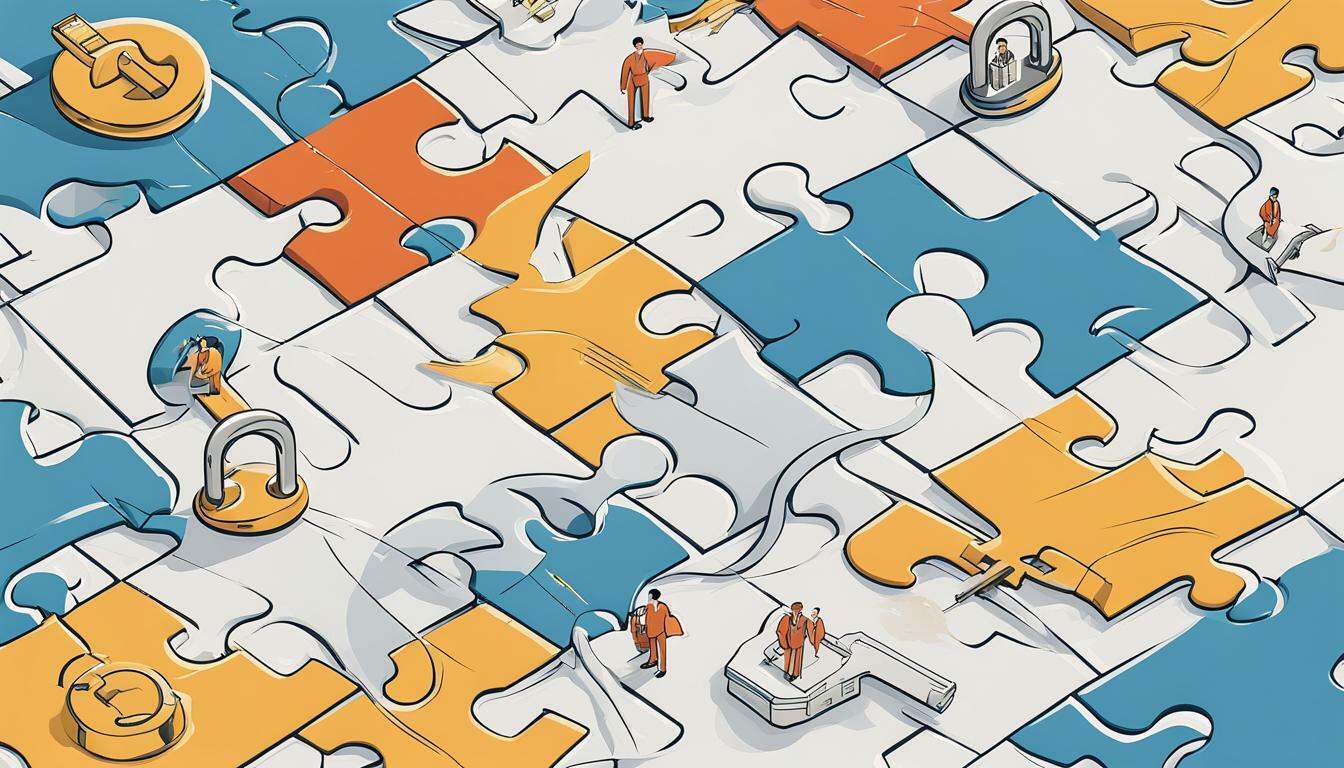
In today’s fast-paced business environment, enterprises must constantly innovate and adapt to stay competitive. However, many organizations are held back by outdated legacy systems that are challenging to maintain and integrate with new technologies. Legacy system integration can help solve this problem, unlocking business value and enhancing performance efficiency.
Legacy systems are software applications or hardware components that are no longer supported or updated by their original manufacturers. These outdated systems can lead to compatibility issues, security vulnerabilities, and a lack of scalability, hindering business operations.
Integrating legacy systems involves connecting them with modern technologies to streamline processes, reduce costs, and improve performance. By doing so, organizations can leverage the benefits of both legacy and modern systems while maintaining data integrity and security.
Key Takeaways
- Legacy systems can hinder business operations due to compatibility, security, and scalability issues.
- Legacy system integration can connect outdated systems with modern technologies to streamline processes and improve performance efficiency.
- Integrating legacy systems can unlock business value while maintaining data integrity and security.
The Benefits of Legacy System Integration
Legacy systems can present significant challenges for organizations, with outdated technology and lack of integration resulting in lower productivity and increased costs. However, upgrading to modern systems can be an expensive and time-consuming process, leading many organizations to continue using their legacy systems despite the challenges.
This is where legacy system integration comes in. By integrating legacy systems with modern technology, organizations can unlock a range of benefits that can enhance productivity, streamline operations, and save costs.
The Challenges of Legacy Systems
Legacy systems can present significant challenges for businesses, including:
- Outdated technology that can’t keep up with modern demands
- Inefficient workflows resulting in lower productivity
- Lack of integration with modern applications and software
- Risk of security vulnerabilities due to outdated systems
These challenges can lead to higher costs, missed opportunities, and reduced competitiveness in the market.
The Benefits of Upgrading Legacy Systems
While upgrading legacy systems can be a costly and time-consuming process, it can also result in significant benefits for organizations. These benefits include:
- Improved productivity through modernized workflows and processes
- Increased efficiency through integration with modern technology
- Better security through modern security measures and patches
- Increased flexibility and agility to respond to changing business needs
- Lower costs in the long-term through reduced maintenance and support costs
The Role of Legacy System Integration
Legacy system integration can help organizations achieve many of the benefits of upgrading their legacy systems, without the high costs and lengthy timeframe. By integrating legacy systems with modern technology, organizations can:
- Streamline workflows and processes for increased efficiency
- Reduce errors and delays by automating manual tasks
- Improve data management and accessibility
- Reduce costs associated with maintaining separate systems
Legacy system integration can also help organizations prepare for digital transformation, enabling them to stay competitive and agile in the fast-paced digital era.
By upgrading legacy systems through integration, organizations can unlock a range of benefits that enhance productivity, streamline operations, and improve overall business performance.
Modernizing Legacy Systems through Integration
Legacy systems can hinder an organization’s ability to operate efficiently and competitively. Fortunately, integrating legacy software into a modern infrastructure can help businesses achieve a more streamlined and productive operation.
The process of modernizing legacy systems through integration involves several steps. Firstly, organizations need to evaluate their current legacy systems and identify areas that require improvement. This can help ensure that the integration process addresses specific pain points and yields the desired results.
Next, organizations need to choose the right integration solution that can seamlessly connect their legacy systems with modern technologies. This could be achieved through API integration, middleware software, or custom solutions that fit unique business requirements.
Once legacy software integration is complete, businesses can start to enjoy the benefits of a more efficient and modernized system. This includes enhanced productivity, agility, and scalability, which can help organizations stay competitive in an ever-changing business landscape.
In conclusion, modernizing legacy systems through integration is essential for organizations that want to remain competitive and efficient. By evaluating current systems, choosing the right integration solution, and embracing new technologies, businesses can unlock the full potential of their legacy systems and pave the way for a successful digital transformation.
Legacy System Migration vs. Modernization
When it comes to legacy systems, organizations often face a critical decision: whether to migrate or modernize their systems. Both approaches have their advantages and disadvantages, and the right choice depends on the organization’s unique circumstances and goals.
Migrating Legacy Systems
Migrating legacy systems involves moving data and applications from an old system to a new one. The new system is usually built from the ground up and provides updated infrastructure, hardware, and software. Migrating legacy systems can be a lengthy and costly process, but it can also provide a fresh start for organizations that want to get rid of outdated technology and streamline their operations.
However, there are also some downsides to legacy system migration. For one, the process can be disruptive to business operations, causing downtime and slowing down productivity. Additionally, it can be challenging to migrate data from legacy systems to new ones, particularly if the legacy system is not properly documented.
Modernizing Legacy Systems
Modernizing legacy systems involves updating existing systems with new technologies, applications, and infrastructure. This approach can be less disruptive than migration since it builds on existing technology rather than replacing it entirely. Modernizing legacy systems can also provide cost savings since organizations can avoid the cost of setting up a new system from scratch.
However, modernizing legacy systems can be challenging since it requires integrating new technology with old infrastructure. Legacy systems often use outdated programming languages and software that are not compatible with modern technology. As a result, modernizing legacy systems can be a lengthy and complex process.
In conclusion, whether to migrate or modernize legacy systems depends on the specific needs and circumstances of each organization. Both approaches have their advantages and disadvantages, but the key is to choose the approach that will provide the most significant benefits for the organization.
The Challenges of Integrating Legacy Applications
Integrating legacy applications can be a complex and challenging process. Legacy systems were designed to function in isolation, and do not always support modern integration standards and protocols. As a result, organizations may encounter a range of obstacles when attempting to integrate their legacy applications with newer technologies.
One of the most significant challenges is ensuring compatibility between legacy and modern systems. Legacy applications may rely on outdated programming languages or database models, which can complicate integration with modern platforms. Additionally, legacy systems may be built on proprietary architectures that are not easily compatible with other systems, requiring custom integration solutions.
Another challenge is data governance. Legacy applications may not have robust data management capabilities, making it difficult to maintain data consistency and integrity during integration. Organizations must ensure that data is accurately mapped and transformed during the integration process to minimize data quality issues.
Overcoming Challenges in Legacy System Integration
To overcome these challenges, organizations should take a strategic approach to legacy system integration. This involves identifying all legacy applications and prioritizing those that are most critical to business processes. It may be necessary to modernize or replace some applications before integrating them with modern systems.
Organizations should also invest in integration technologies that can handle the complexities of legacy system integration. Integration platforms with pre-built connectors and adapters can simplify integration by providing out-of-the-box support for legacy systems. Additionally, organizations should consider working with experienced integration partners who can help navigate the complexities of legacy system integration.
Best Practices for Legacy System Integration
Integrating legacy applications can be a complex and challenging process. To ensure a successful integration, organizations need to follow best practices tailored to their specific needs. Here are some best practices for successful legacy system integration:
- Define clear objectives: Before starting the integration process, it’s important to identify clear objectives and goals to ensure that the integration aligns with business needs. This will help measure the success of the integration and ensure it delivers the intended results.
- Assess your current infrastructure: It’s important to have a clear understanding of your current infrastructure and the legacy systems you want to integrate. This will help identify potential roadblocks and challenges that may arise during the integration process.
- Choose the right integration strategy: Organizations need to choose the right integration strategy that aligns with their business objectives and current infrastructure. Options include point-to-point integration, middleware, and API-led integration.
- Use a phased approach: To minimize disruption, it’s best to adopt a phased approach to integration. This involves breaking down the integration process into smaller, manageable phases that can be implemented gradually.
- Ensure data quality: Integrating legacy systems often involves dealing with data from multiple sources. To ensure the data is accurate and reliable, it’s important to establish data quality standards and perform data cleansing and validation.
- Ensure security and compliance: Integrating legacy systems can pose security and compliance risks. To mitigate these risks, organizations need to establish proper access controls, encryption, and compliance monitoring.
- Perform rigorous testing: Before deploying the integrated system, it’s important to perform rigorous testing to identify and resolve any issues.
By following these best practices, organizations can ensure a smooth integration process that maximizes the benefits of integrating legacy systems.
Choosing the Right Integration Solution
Integrating legacy systems can be a complex process, and choosing the right integration solution is crucial to its success. Here are some factors to consider when selecting an integration solution:
- Scalability: Make sure the integration solution can scale to meet your organization’s growth needs.
- Compatibility: Ensure that the integration solution is compatible with your current IT infrastructure and legacy systems.
- Cost-effectiveness: Determine if the integration solution fits within your budget and if the benefits outweigh the costs.
There are different integration approaches, including point-to-point and service-oriented architecture (SOA) integration. Point-to-point integration connects legacy systems directly, while SOA integration uses a middleware layer for improved flexibility and scalability. Ultimately, the right integration approach depends on your organization’s needs and requirements.
The Role of Legacy System Integration in Digital Transformation
Legacy systems are a common challenge for organizations undergoing digital transformation. Many of these systems were built decades ago and are outdated or unsupported, making it difficult to integrate them with modern technologies and systems. However, legacy system integration is essential for driving digital transformation and achieving business success in the digital era.
The Importance of System Integration
System integration is the process of connecting different applications, systems, and technologies to create a unified and seamless workflow. This approach enables organizations to leverage and optimize their existing systems and technologies, while also integrating new solutions to address emerging challenges and opportunities.
Legacy system integration is a crucial component of digital transformation, as it enables organizations to modernize their existing infrastructure and leverage the benefits of cloud computing, big data analytics, artificial intelligence, and other advanced technologies. By integrating legacy systems with modern technologies, businesses can improve their agility, efficiency, and competitiveness, while also enhancing their customer experience and driving innovation.
The Benefits of Legacy System Integration for Digital Transformation
There are several benefits of legacy system integration for digital transformation, including:
- Improved efficiency: Integrating legacy systems with modern technologies can streamline workflows, eliminate redundant processes, and enhance overall productivity.
- Enhanced scalability: Legacy integration enables organizations to scale their IT infrastructure as needed, without the prohibitive costs of a full system overhaul.
- Better data management: By integrating legacy systems with modern data management solutions, organizations can gain real-time insights and actionable intelligence.
- Increased innovation: Legacy system integration enables businesses to leverage the latest technologies and solutions, driving innovation and disrupting traditional business models.
Legacy System Integration Best Practices
When it comes to legacy system integration, there are several best practices that organizations should follow to ensure success:
- Assess your existing infrastructure: Before integrating legacy systems, it’s critical to understand your existing infrastructure, including its strengths, weaknesses, and compatibility with modern technologies.
- Develop a comprehensive integration strategy: A well-defined integration strategy is essential for success, including a detailed plan for implementing, testing, and refining the integration process.
- Engage stakeholders across the organization: Legacy system integration requires a collaborative effort across multiple departments and stakeholders, including IT, operations, finance, and customer service.
- Choose the right integration solution: There are several integration solutions available, including middleware, APIs, and custom integrations. Choosing the right solution is essential for optimal performance, compatibility, and scalability.
- Maintain ongoing system monitoring and maintenance: Legacy system integration is an ongoing process, requiring ongoing monitoring, maintenance, and updates to ensure optimal performance and security.
The Future of Legacy System Integration
The future of legacy system integration lies in the continued evolution of cloud-based and hybrid integration solutions, as well as the increasing adoption of containerization and microservices architectures. These approaches enable organizations to integrate legacy systems with modern technologies quickly and efficiently, enabling faster time-to-market, greater agility, and better customer experiences.
As businesses continue to shift toward a more digital landscape, legacy system integration will remain a critical component of digital transformation, enabling organizations to leverage their existing systems and technologies while also adopting new solutions to drive innovation and growth.
Legacy System Integration Case Studies
Real-world case studies illustrate how legacy system integration can unlock business value and streamline operations to achieve significant results. Here are some examples of organizations that leveraged legacy system integration:
| Company | Industry | Integration Solution | Results |
|---|---|---|---|
| ABC Corporation | Manufacturing | Legacy System Integration with Cloud-based ERP | Reduced inventory costs by 20%, increased productivity by 15%, and improved order accuracy by 25%. |
| XYZ Enterprises | Finance | Legacy System Integration with CRM | Improved customer retention by 30%, increased sales by 25%, and reduced customer complaints by 40%. |
| LMN Corporation | Healthcare | Legacy System Integration with Electronic Health Record (EHR) | Improved patient care by providing real-time access to critical data, reduced administrative costs by 35%, and increased revenue by 20%. |
These case studies demonstrate how legacy system integration can enable organizations across diverse industries to achieve significant business value. By integrating legacy systems with modern technologies, businesses can streamline operations, reduce costs, improve productivity, enhance customer experience, and gain a competitive edge.
The Future of Legacy System Integration
The integration of legacy systems with modern technologies is a constantly evolving process. As businesses continue to embrace digital transformation, legacy system integration will play an increasingly critical role in driving innovation and business success.
One of the emerging trends in legacy system integration is the use of cloud-based integration platforms. Cloud-based solutions offer more scalability, flexibility, and cost-effectiveness compared to on-premise integration solutions. With the increasing adoption of cloud computing, cloud-based integration solutions will only continue to gain popularity.
Another trend is the use of APIs (Application Programming Interfaces) for legacy system integration. APIs enable legacy systems to interact with modern applications, allowing businesses to leverage the full potential of their legacy systems while also taking advantage of the latest technologies.
As artificial intelligence (AI) and machine learning continue to advance, legacy system integration will also play a critical role in integrating these technologies into existing systems. AI-powered integration solutions can help businesses automate workflows, reduce errors, and improve decision-making.
Looking ahead, legacy system integration will continue to be a crucial element in driving business innovation and success. By staying up to date with the latest technology trends and solutions, organizations can ensure they are leveraging the full potential of their legacy systems and keeping pace with the rapidly evolving business landscape.
Measuring the Success of Legacy System Integration
Integrating legacy systems can lead to significant business value. However, it’s important to measure the success of integration efforts to ensure they are delivering the expected results. Here are some key performance indicators to consider:
- Improved efficiency: One of the most significant benefits of legacy system integration is improved efficiency. To measure this, track the time it takes to complete key business processes before and after integration. You should see a noticeable decrease in the time it takes to complete these processes.
- Cost savings: Legacy system integration can also lead to cost savings. Track the costs associated with maintaining and operating legacy systems before and after integration. You should see a reduction in these costs.
- Increased productivity: Integration can lead to increased productivity among employees. Track employee productivity before and after integration to see if there are any noticeable improvements.
- Better data quality: Integration can also lead to better data quality. Track the accuracy of data before and after integration to see if there are any improvements.
By tracking these key performance indicators, you can measure the success of your legacy system integration efforts and ensure they are delivering the expected results.
Conclusion
In conclusion, integrating legacy systems is key to unlocking business value and remaining competitive in the digital age. Legacy systems can pose significant challenges, but integrating them with modern technology can streamline operations, increase efficiency, and improve overall performance.
As we have discussed, organizations can choose between migrating or modernizing their legacy systems, depending on their specific needs. Overcoming challenges during the integration process requires careful planning and implementation of best practices.
Choosing the right integration solution is crucial, and organizations must consider factors such as scalability, compatibility, and cost-effectiveness. Successful legacy system integration can have a significant impact on business outcomes, and measuring its success requires tracking key performance indicators.
Looking ahead, the future of legacy system integration will involve new technologies, emerging trends, and innovative strategies. By embracing these changes, organizations can continue to leverage integration to drive business innovation and growth.
Overall, legacy system integration is an important investment for any organization looking to improve efficiency, streamline operations, and unlock business value. By taking the necessary steps to integrate legacy systems with modern technology, organizations can stay ahead of the curve and thrive in the digital age.
FAQ
Q: What are legacy systems?
A: Legacy systems refer to outdated software or hardware that is still in use by an organization. These systems are often outdated in terms of technology and may no longer be supported by the original vendor.
Q: Why is legacy system integration important?
A: Legacy system integration is important because it allows organizations to streamline their operations and improve performance efficiency. By integrating legacy systems, businesses can take advantage of modern technologies and processes, resulting in increased productivity and cost savings.
Q: What are the benefits of legacy system integration?
A: Legacy system integration offers several benefits, including improved business performance, enhanced data accuracy, increased agility, reduced maintenance costs, and the ability to leverage modern technologies and processes.
Q: How can legacy systems be modernized through integration?
A: Legacy systems can be modernized through integration by incorporating new technologies and processes into the existing infrastructure. This can involve integrating legacy software into a more modern architecture or migrating to a new system while retaining the valuable data and functionality of the legacy system.
Q: What is the difference between legacy system migration and modernization?
A: Legacy system migration involves moving from an old system to a new one, while modernization involves updating and improving the existing legacy system. Migration typically involves more significant changes and may require transferring data and functionality to a completely different platform, while modernization focuses on enhancing the existing system.
Q: What are the common challenges faced in legacy system integration?
A: Common challenges in legacy system integration include compatibility issues between legacy systems and modern technologies, data migration complexities, limited documentation, and resistance to change from users. These challenges can be overcome with proper planning, testing, and communication.
Q: What are the best practices for successful legacy system integration?
A: Best practices for successful legacy system integration include conducting a thorough assessment of legacy systems, creating a detailed integration plan, involving all stakeholders early in the process, ensuring proper documentation, conducting comprehensive testing, and providing training and support to users.
Q: How can organizations choose the right integration solution for their legacy systems?
A: Organizations should consider factors such as scalability, compatibility with existing systems, cost-effectiveness, ease of implementation and maintenance, and vendor reputation when choosing an integration solution for their legacy systems.
Q: What is the role of legacy system integration in digital transformation?
A: Legacy system integration plays a crucial role in enabling digital transformation within organizations. By integrating legacy systems with modern technologies, businesses can leverage the power of digital to stay competitive, improve customer experiences, and drive innovation.
Q: Can you provide examples of successful legacy system integration?
A: Yes, there are many real-world case studies that demonstrate the successful implementation of legacy system integration. These case studies showcase organizations from various industries that have achieved significant business value by integrating their legacy systems.
Q: What does the future hold for legacy system integration?
A: The future of legacy system integration is promising, with emerging trends, technologies, and strategies shaping the way organizations integrate their legacy systems. The focus will be on leveraging modern technologies such as cloud computing and AI to enhance the capabilities of legacy systems and drive further business innovation.
Q: How can organizations measure the success of their legacy system integration efforts?
A: Organizations can measure the success of their legacy system integration efforts by tracking key performance indicators (KPIs) such as improved productivity, reduced errors, cost savings, increased customer satisfaction, and enhanced business agility.








